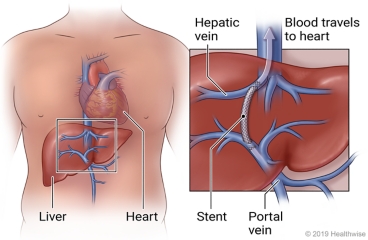Learning About Transjugular Intrahepatic Portosystemic Shunt (TIPS)
What is TIPS?

TIPS is a procedure in which a tube called a stent is placed to join two veins in a damaged liver. One vein
carries blood to the liver (portal vein) from the legs and belly. Another vein goes from the liver to the
heart (hepatic vein).
The scar tissue in a damaged liver can prevent the blood from filtering through the liver. This can cause
high blood pressure in the portal vein. TIPS forms a channel that allows some of the blood to bypass the
liver. This lowers the pressure and makes veins less likely to rupture and bleed.
Why is it done?
TIPS is used to reduce high blood pressure in the portal vein that carries blood from the intestines to the
liver.
TIPS may be used to:
-
Treat fluid buildup that continues to happen even though other treatment has been tried. The buildup often
happens in the belly.
-
Treat the bleeding that can happen when veins swell and break open because of the high pressure. This is
called variceal bleeding. TIPS may be used when other treatments for the bleeding don't help or while you
are waiting for a liver transplant.
How is it done?
A TIPS procedure may be done by a radiologist, who places a wire-mesh stent through another tube called a
catheter. It goes into a vein in the neck. The doctor threads the catheter to the liver and places the stent
to join the two veins. The stent is then expanded using a small balloon.
What are the risks of transjugular intrahepatic portosystemic shunt (TIPS)?
Problems from a TIPS procedure may include:
-
Encephalopathy. This happens when the liver is less able to filter toxins from the bloodstream. The toxins
build up in the bloodstream and cause problems in your brain.
-
Problems with the stent, such as narrowing (stenosis) or closing (occlusion).
-
Bleeding.
-
Damage to the blood vessels.
What can you expect after a TIPS procedure?
You may go home the same day or the next day after a TIPS procedure. Your doctor or nurse checks to make sure
that you're not having any problems before you go home.
Current as of: July 26, 2023
Content Version: 14.0
Care instructions adapted under license by your
healthcare professional. If you have questions about a medical condition or this instruction, always ask
your healthcare professional. Healthwise, Incorporated disclaims any warranty or liability for your use of
this information.